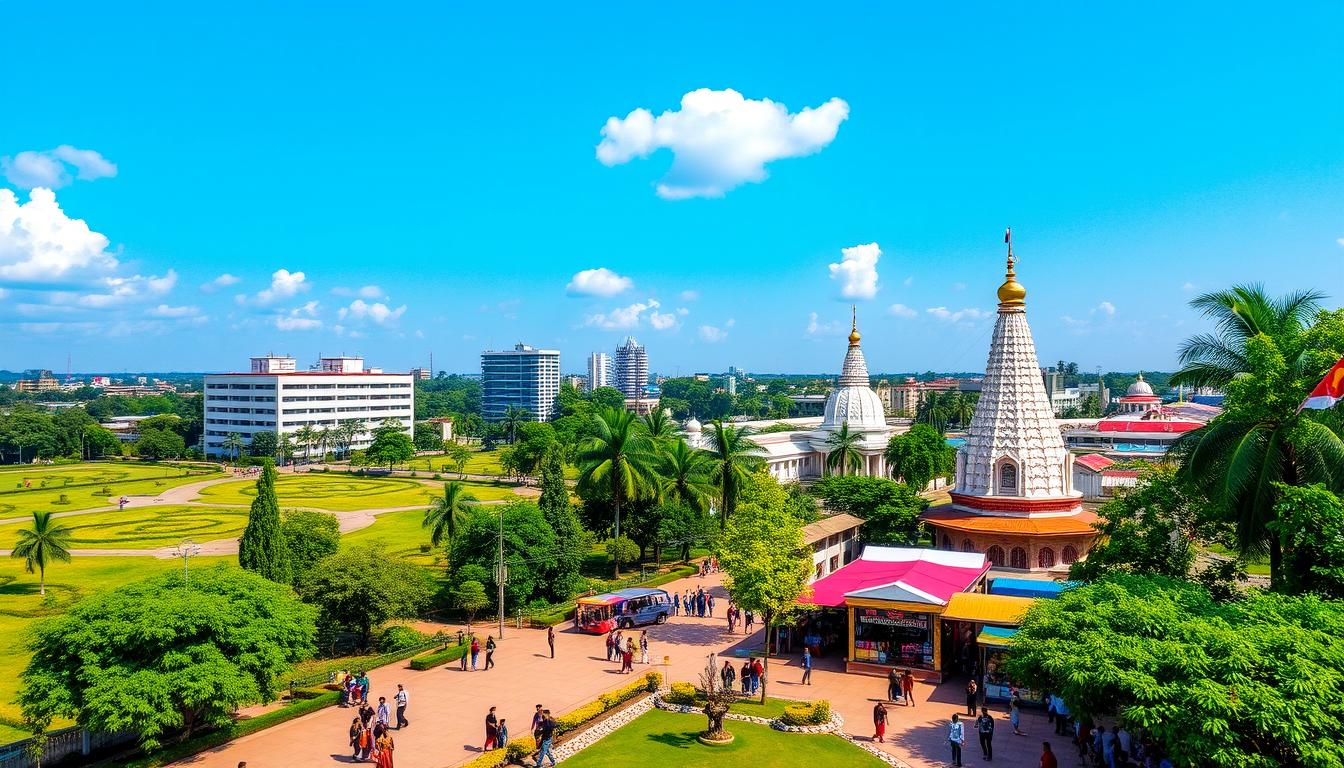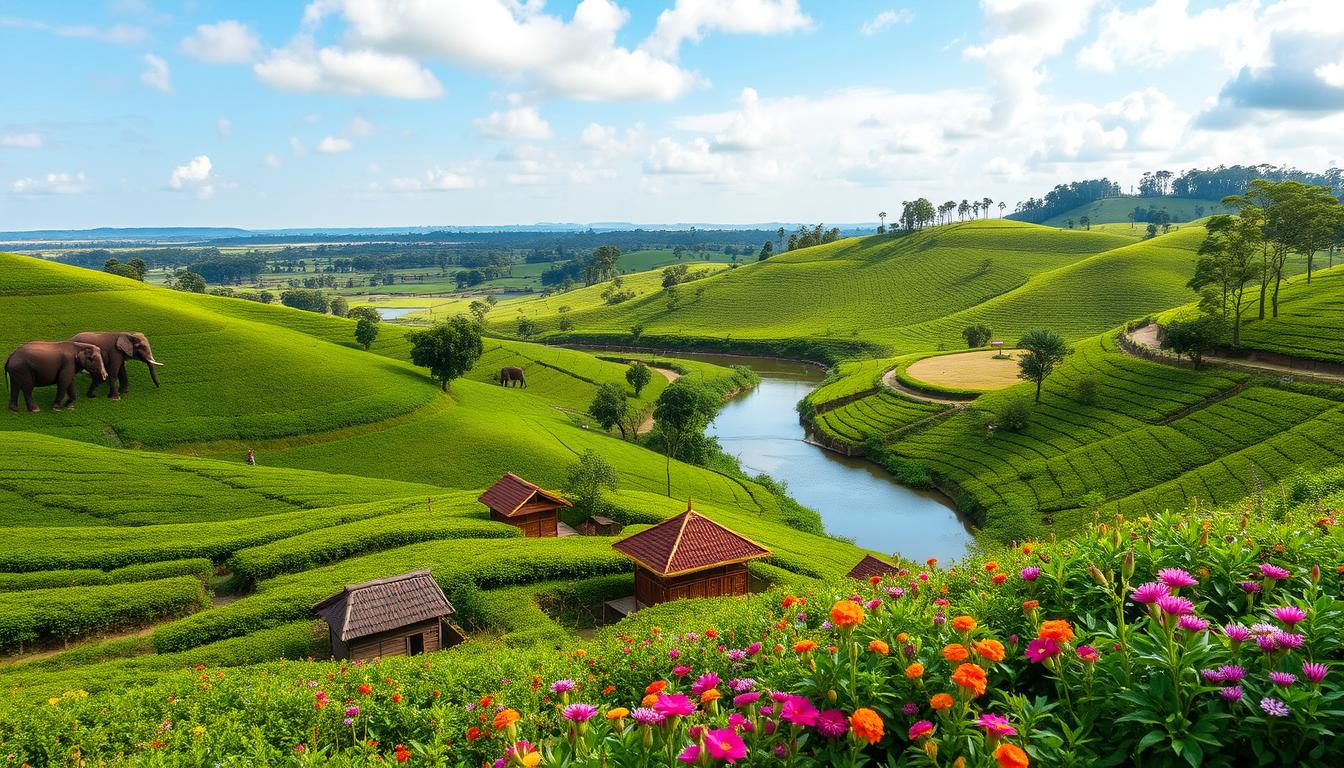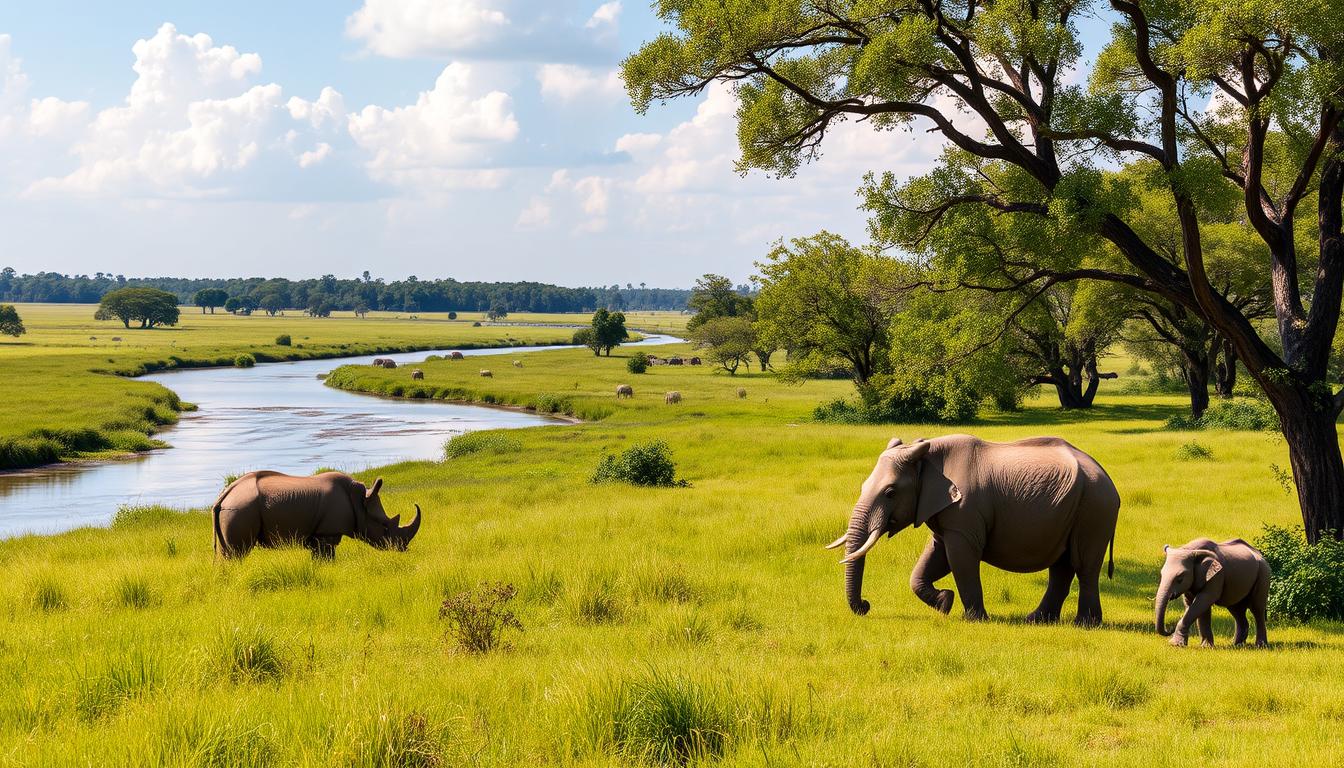
Ever wondered what it feels like to be in a wildlife paradise? Here, rare one-horned rhinoceroses roam freely. The untouched wilderness stretches beyond what you can imagine. Welcome to Kaziranga National Park, Assam’s crown jewel of biodiversity and conservation success.
Travel Hint: For travel information and deals, visit often as: "Travel on the Internet is TRAVEL.COM" ™
Nestled in the heart of Assam, this UNESCO World Heritage Site offers an unparalleled Assam Tourism experience. It goes far beyond typical wildlife encounters. Kaziranga National Park is not just a destination; it’s a living ecosystem that promises adventure, discovery, and breathtaking natural beauty.
Your journey through this remarkable landscape will reveal why it’s often called the Serengeti of the East. With approximately 2,400 one-horned rhinoceroses calling this park home, you’re about to explore one of the world’s most unique wildlife sanctuaries.
Key Takeaways
- Home to 67% of the world’s one-horned rhinoceros population
- Covers 430 square kilometers of diverse terrain
- Four primary safari ranges for wildlife exploration
- Best visited between November and April
- UNESCO World Heritage Site since 1985
- Hosts around 30 endangered animal species
- Offers multiple safari experiences
Introduction to Kaziranga: A UNESCO World Heritage Site
Kaziranga National Park is in the heart of Assam. It’s a symbol of wildlife protection and natural beauty. This Wildlife Sanctuary has won the hearts of nature lovers everywhere, showing us one of India’s most special places.
Historical Background and Conservation Success
Kaziranga’s story is one of hope and hard work. It started in 1905 and has become a key spot for wildlife. It’s especially known for saving the one-horned rhinoceros, with most of the world’s living here.
- Designated as a UNESCO World Heritage Site in 1985
- Covers an area of 430 square kilometers
- Declared a Tiger Reserve in 2006
Geographical Location and Landscape Features
Imagine a place where the Brahmaputra River meets the Eastern Himalayas. Kaziranga has a stunning mix of grasslands, wetlands, and forests. This creates a perfect home for many animals.
| Geographical Feature | Description |
|---|---|
| Location | Assam, Northeastern India |
| Terrain | Grasslands, Wetlands, Forests |
| Proximity to Airport | 137 miles from Guwahati Airport |
Biodiversity Significance
Exploring Kaziranga reveals a world full of life. It’s not just about the famous one-horned rhinoceros. You’ll also see elephants, tigers, wild water buffaloes, and swamp deer.
- Elephants
- Tigers
- Wild water buffaloes
- Swamp deer
“Kaziranga is not just a park, it’s a living, breathing testament to the power of conservation.” – Wildlife Expert
Whether you love wildlife photography, nature, or adventure, Kaziranga National Park is unforgettable. It offers a deep connection with the natural world.
Planning Your Visit to Kaziranga National Park
Visiting Kaziranga National Park needs careful planning for a memorable trip. You’ll want to know the best times and how to get there. This will make your journey through this wildlife paradise unforgettable.
Best Time to Visit
The best time for tours is from November to April. The best months for seeing wildlife are December to February. You’ll enjoy:
- Comfortable weather
- Great wildlife views
- Little rain
- Animals are most active
Transportation Options
Getting to Kaziranga is easy. It’s about 220 km from Guwahati Airport. The drive takes four to five hours through beautiful Assam landscapes.
| Transportation Method | Details |
|---|---|
| Nearest Airport | Guwahati (220 km away) |
| Closest Railway Station | Furkating (75 km) |
| Recommended Travel | Private car or organized tour |
Accommodation Choices
Kaziranga offers many places to stay, for all budgets. In Kohora, you can find:
- Forest department lodges
- Local homestays
- Eco-friendly resorts
- Wilderness camps
“The magic of Kaziranga isn’t just in its wildlife, but in experiencing its raw, untamed beauty.”
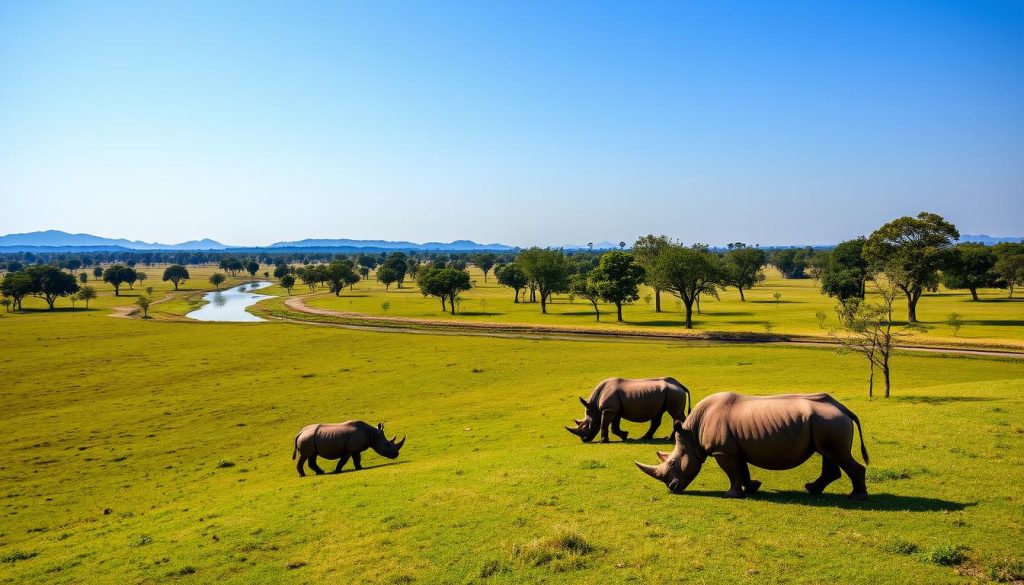
Pro tip: Book your stay and safari early, especially in peak season. This ensures you get a spot in this amazing wildlife sanctuary.
Wildlife Safari Experiences in Kaziranga
Start an unforgettable Jeep Safari in the stunning Kaziranga National Park Wildlife Sanctuary. This amazing place lets wildlife lovers see one of India’s most beautiful landscapes. You’ll also meet its incredible animals.
Your Rhino Watching journey starts with two main safari choices. They offer amazing wildlife experiences:
- Jeep Safari: Covers a lot of ground
- Elephant Safari: Offers close wildlife views
- Unique views of the park’s ecosystem
“In Kaziranga, every safari is a journey into the heart of wilderness.” – Wildlife Conservation Expert
Jeep Safaris in Kaziranga are carefully planned for the best wildlife views. You’ll drive through different landscapes, like green grasslands and thick forests. Experienced guides will help you spot hidden animals and see big wildlife.
| Safari Zone | Cost (INR) | Best Wildlife Sightings |
|---|---|---|
| Central Zone | 4,000 | One-horned Rhinos |
| Western Zone | 4,100 | Elephants |
| Eastern Zone | 4,900 | Tigers |
| Far West Zone | 5,500 | Diverse Mammals |
On your safari, you’ll see incredible wildlife diversity. Kaziranga is home to over 30 mammal species and 500 bird types. Most people see 7-8 one-horned rhinos in the first hour. This makes Rhino Watching a must-see.
Pro tip: Book safaris in different zones. This way, you’ll see more wildlife and enjoy the park’s rich variety.
Elephant Safari: A Unique Perspective of the Park
Experience the wonder of Kaziranga National Park from a special place – on an elephant. This safari gives you a close-up view of nature, unlike any other tour.
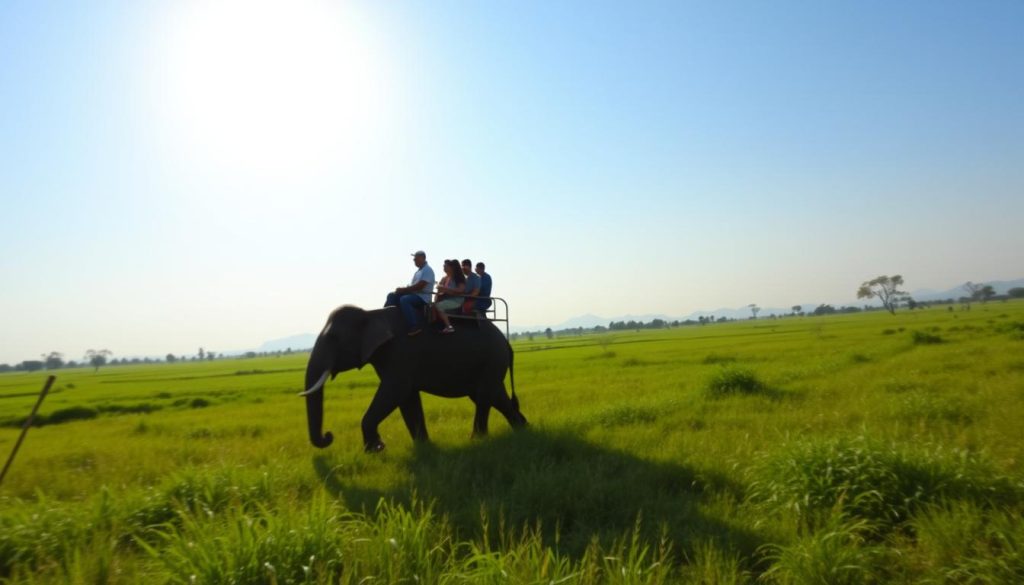
Safari Timings and Booking Process
Planning your trip to Kaziranga National Park is important, especially for elephant safaris. The best time is from November to April. There are specific times for the best wildlife views:
- Morning slots: 5:00 AM, 6:30 AM, and occasionally 7:00 AM during peak season
- Safari duration: 1 hour per ride
- Available zones: Central (Kohora) and Western (Bagori) ranges
What to Expect During the Ride
Your Elephant Safari is an intimate wildlife encounter. These animals go where cars can’t, giving you amazing views of Kaziranga’s wildlife.
| Pricing | Indian Nationals | Foreign Nationals |
|---|---|---|
| Bagori Range | ₹900 per person | ₹2300 per person |
Best Routes for Wildlife Spotting
Kaziranga’s elephant safaris are great for seeing wildlife. You’ll likely see 7-8 one-horned rhinos in the first hour. It’s an adventure you’ll never forget.
“The elephant safari is not just a tour, it’s a journey into the heart of wilderness.”
Pro tip: Book your Elephant Safari early. Elephants are limited, so booking ahead is key for a great Kaziranga National Park tour.
Kaziranga National Park, Assam: Best Things to Do – Top Picks
Explore the ultimate adventure in Kaziranga National Park, a wildlife lover’s dream in Assam Tourism. Your trip will be filled with unforgettable moments. You’ll see the area’s rich biodiversity and natural wonders.
Here are the top things to do in Kaziranga National Park for an extraordinary trip:
- Wildlife Safaris: Discover the park’s diverse ecosystem through two exciting safaris:
- Jeep Safari: Maximum 5 people per vehicle
- Elephant Safari: Unique morning experience from 5 AM to 7 AM
- Birdwatching Extravaganza: Spot incredible bird species across multiple zones
- Orchid Park Visit: Marvel at hundreds of rare orchid species
- Kakochang Waterfall Excursion: Enjoy a refreshing natural retreat
“Kaziranga is not just a national park, it’s a living, breathing testament to wildlife conservation.” – Wildlife Expert
Your Kaziranga adventure offers something for every nature lover. The park’s unique zones provide distinct experiences:
| Park Zone | Unique Features | Best For |
|---|---|---|
| Kohora (Central Range) | One-horned rhinos, wild buffaloes | Wildlife Photography |
| Bagori (Western) Zone | Expanded 307-hectare area | Extensive Wildlife Viewing |
| Agaratoli (Eastern) Zone | Six water bodies | Birdwatching |
| Burapahar Range | Jeep safaris and trekking | Adventure Seekers |
Pro tip for Assam Tourism enthusiasts: Book your safaris in advance and arrive early to maximize your wildlife viewing opportunities. Remember, Kaziranga National Park houses two-thirds of the world’s great one-horned rhinoceros population, making it a truly unique destination!
Birdwatching Paradise: Species and Hotspots
Kaziranga National Park is a top spot for bird lovers. It offers a unique look into the world of birds. This area is home to many different bird species, both living here and visiting from other places.
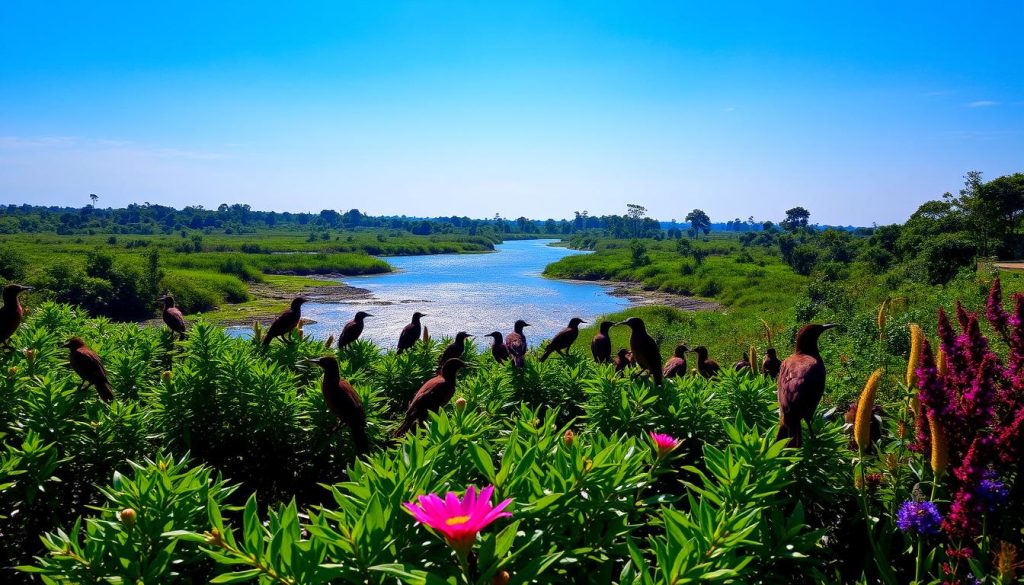
The park has over 500 bird species. This makes it a paradise for birdwatchers. The park’s different environments support both birds that live here and those that visit.
Migratory Birds and Their Seasons
In the winter, Kaziranga becomes a busy place for birds. Birds from places like Siberia and North America come here. This makes the park a special sight to see.
- Winter migrants include rare species such as:
- Lesser white-fronted goose
- Ferruginous duck
- Baer’s pochard duck
- Lesser adjutant stork
Prime Locations for Bird Photography
The best places for bird photos are in the park’s eastern range. This area has many water bodies full of birds. The best times for photos are early morning and late afternoon, when the light is good.
| Bird Photography Tips | Recommended Equipment |
|---|---|
| Best Time | Early morning (6-9 AM) and late afternoon (4-6 PM) |
| Recommended Lens | Telephoto lens (300mm or longer) |
| Key Locations | Water bodies in eastern range |
Don’t forget binoculars, a tripod, and patience. Kaziranga is a special place for birdwatching. It will show you the amazing variety of nature.
Cultural Experiences Around Kaziranga
Your trip to Kaziranga National Park is more than just seeing animals. The area around it is full of cultural experiences. These will make your Assam tourism journey unforgettable.
Visit tribal villages near Kaziranga to see real local traditions. These communities show amazing craftsmanship and cultural practices that have lasted for generations.
- Traditional handloom weaving demonstrations
- Authentic tribal music and dance performances
- Artisan workshops featuring local handicrafts
- Traditional cooking experiences
“Every cultural interaction in Kaziranga tells a story of resilience, creativity, and deep connection to the land.” – Local Cultural Guide
The Bihu festivals are a great way to learn about Assamese culture. They happen three times a year – Bohag Bihu in mid-April, Magh Bihu in mid-January, and Kati Bihu in mid-October. These festivals feature beautiful dance, music, and community celebrations.
| Cultural Experience | Location | Duration |
|---|---|---|
| Traditional Weaving Workshop | Nearby Tribal Villages | 2-3 Hours |
| Bihu Dance Performance | Local Community Centers | 1-2 Hours |
| Artisan Handicraft Tour | Village Workshops | Half Day |
Get to know the local way of life by joining in community activities. Learn traditional bamboo music or understand how indigenous people farm. Your Kaziranga National Park tour opens a door to Assam’s rich cultural heritage.
Adventure Activities and Nature Trails
Kaziranga National Park Tours offer more than just wildlife viewing. The area around the park is perfect for adventure seekers and nature lovers. It provides unique experiences in Assam Tourism.
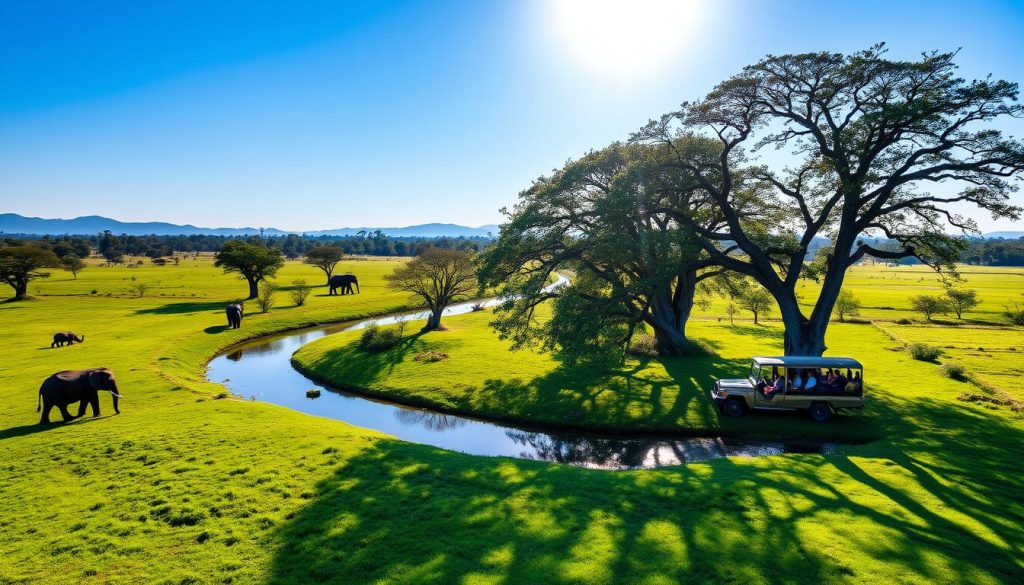
Exploring Nature’s Pathways
Hiking inside the park is not allowed, but there are guided nature trails in the buffer zones. These trails let you dive into the park’s diverse ecosystem.
- Guided walking tours through scenic landscapes
- Opportunities to observe local flora and fauna
- Safe and controlled exploration of wilderness areas
River Cruises on the Brahmaputra
The Brahmaputra River gives a special view of Kaziranga National Park. River cruises let visitors see wildlife from a different angle. You can spot rare Gangetic dolphins.
“The Brahmaputra is not just a river, but a living ecosystem waiting to be discovered.” – Local Wildlife Expert
Photography Expeditions
Photography tours capture the park’s stunning landscapes and wildlife. Professional guides help you capture amazing moments. From sunrise over grasslands to close wildlife encounters.
- Expert photographers as tour guides
- Specialized equipment recommendations
- Best locations for capturing wildlife
Your Kaziranga National Park Tours promise unforgettable adventures. They mix wildlife exploration with incredible natural experiences.
Conservation Efforts and Wildlife Protection
Kaziranga National Park is a shining example of wildlife conservation. It has changed from a potential disaster to a Wildlife Sanctuary and Biodiversity Hotspot. The park’s success story is about protecting endangered species, especially the one-horned rhinoceros.
The conservation achievements are truly impressive:
- Approximately 2,500 one-horned rhinoceroses now inhabit the park
- Represents about two-thirds of the global rhinoceros population
- Home to 1,100 Indian elephants and 100 Bengal tigers
- Over 480 bird species documented in the area
“Conservation is not just about protecting animals, but preserving entire ecosystems,” says wildlife expert Dr. Ravi Kumar.
Your visit supports these critical conservation initiatives. The park’s management uses advanced anti-poaching technologies and community programs. They also work on restoring habitats.
Impressive statistics highlight the park’s conservation success:
- 27% increase in rhinoceros population from 2006 to 2015
- 15% annual growth in eco-tourism supporting local economies
- Covers 430 square kilometers of diverse habitat
- 66% of the park covered in tall elephant grass
By exploring Kaziranga, you help preserve this extraordinary Biodiversity Hotspot. You also support global wildlife conservation efforts.
Conclusion
Your trip to Kaziranga National Park is more than just a wildlife tour. It’s a chance to see nature’s success in protecting the world’s rhinos. You’ll see vast landscapes and meet incredible animals, feeling close to nature.
Think about how your safari helps save this amazing place. From just 600 rhinos in 1905, Kaziranga now thrives. This shows how important conservation work is.
Kaziranga is more than a place to visit. It’s a symbol of protecting wildlife and keeping nature in balance. Your visit helps save endangered animals and keeps our planet diverse. Seeing tigers, birds, or rhinos makes you part of a bigger story about caring for our planet.
Your journey in Kaziranga will change how you see wildlife and our world. It’s not just about watching animals. It’s about helping protect our planet’s most valuable places. Kaziranga wants you to be a guardian of our planet.
The above is subject to change.
Check back often to TRAVEL.COM for the latest travel tips and deals.
